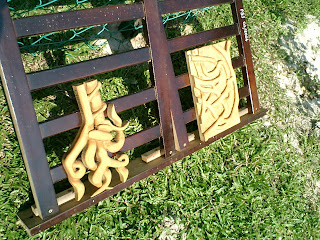SKETCH
A sketch is a drawing or other composition that is not intended as a finished work. Sketches usually serve to store ideas for later use. In a similar manner, the word can be used to indicate an impression of something.
LAKARAN
Lakaran adalah lukisan atau sesuatu gubahan yang tidak bermaksud kerja atau karya yang sudah siap. Lakaran biasanya merupakan rakaman idea yang boleh digunakan kemudian. Lakaran juga boleh menunjukkan tanggapan dan perasaan terhadap sesuatu.
DRAWING
Drawing is one way of making an image: it is the process of making marks on a surface by applying pressure from or moving a tool on the surface. These marks may represent what the artist sees when drawing, a remembered or imagined scene or abstraction.
LUKISAN
Lukisan adalah salah satu cara menghasilkan imej atau gambaran: ia adalah proses membuat tanda di atas permukaan dengan kaedah menekan daripada atau gerakan alat di atas permukaan. Tanda-tanda ini mewakili apa yang dilihat oleh pelukis, ingatan atau gambaran dalam fikiran atau perkara mujarad.
Lukisan biasanya dirujuk dengan penggunaan media kering seperti pensil, pensil warna, arang dll.
PAINTING
Painting is the practice of applying pigment suspended in a carrier (or medium) and a binding agent (a glue) to a surface (support) such as paper, canvas or a wall.
CATAN
Catan ialah kaedah atau teknik mengenakan pigmen warna yang terdapat dalam bahan perantara (atau medium) dan agen tautan (perekat) kepada permukaan (sokongan) seperti kertas, kanvas atau dinding.
Catan biasanya dirujuk dengan penggunaan media basah seperti cat air, cat poster, cat minyak, akrilik dll.




 ADA BANYAK LAGI...TAPI TERIMA KASIH KEPADA CIKGU FAIRUZ PASAL AMBIK SEMUA PICT NIDARI BLOG DIA. WALAUPUN LEPAS TU KAMERA DIA HILANG DEK SEGELINTIR HATI MEREKA YANG HITAM...
ADA BANYAK LAGI...TAPI TERIMA KASIH KEPADA CIKGU FAIRUZ PASAL AMBIK SEMUA PICT NIDARI BLOG DIA. WALAUPUN LEPAS TU KAMERA DIA HILANG DEK SEGELINTIR HATI MEREKA YANG HITAM...
